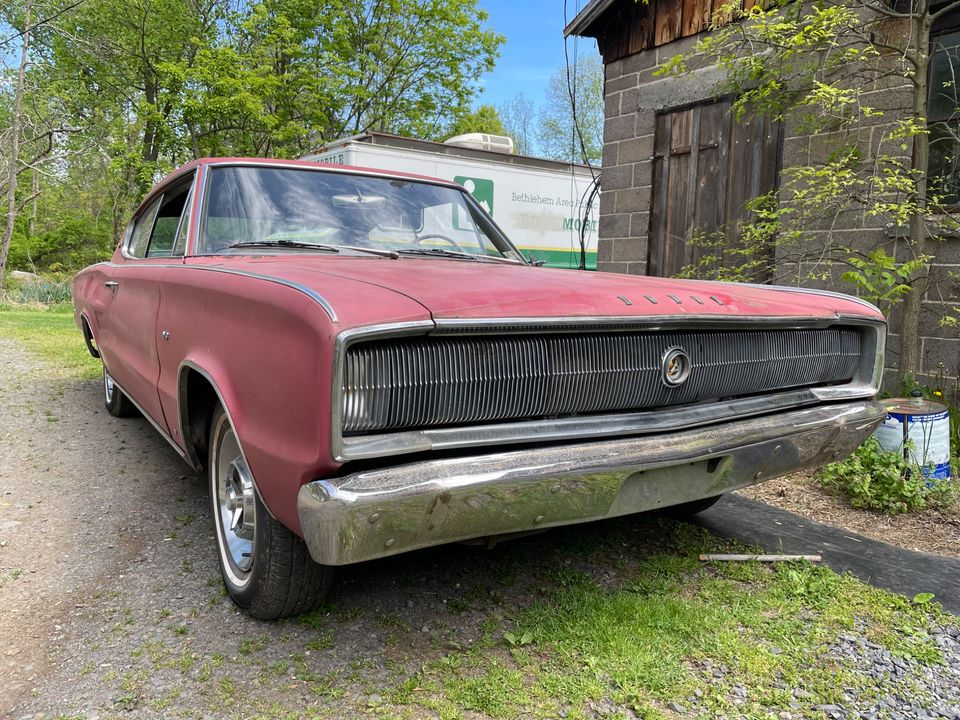The original B-body Dodge Charger is widely known as one of the most iconic muscle cars ever built. However, Dodge had something a bit different in mind when it introduced the nameplate in 1966. Specifically, the company noticed that it wasn’t just the pony car market that was growing fast. Luxury coupes were also becoming more popular. And the 1966 Dodge Charger was an answer to both trends.
Utilizing lessons learned from the Chrysler 300 “letter series” introduced in the 1950s, Dodge sought to create a midsize car to slot between the Ford Mustang and the notably more expensive Ford Thunderbird, described as a personal luxury car at the time. But Dodge also intended to keep it relatively affordable. Hence, the plan was to create a sporty-looking and spacious fastback while sharing as many existing components as possible. And this was achieved by using the Coronet as a base.
Much like the 1965 Rambler Marlin, the first-year Charger looked rather radical upon arrival. And it wasn’t just the swooping fastback design. The hidden headlamps, the razor-style front grille, and the full-width taillamp panel were also quite exotic at the time. Inside, it had a full-length center console and rear bucket seats instead of the usual bench. Additionally, the buckets could be folded down completely to create a massive luggage area accessible via the rear hatch.

To top it all off, Dodge eliminated the inline-six engine that came standard in the Coronet and kept the Charger a V8-only affair. It also used the fastback to introduce the streetable 426-cubic-inch (7.0-liter) HEMI V8, which became Chrysler’s most iconic powerplant.
The Charger’s initial luxed-up phase lasted for only two years. In 1968, Dodge gave it a big overhaul, turning the sporty fastback into a full-blown muscle car. The company also replaced the folding rear bucket seats with a conventional bench and even introduced a slant-six engine.
Come 2023, Chargers built from 1968 to 1971 are notably more desirable than the earlier versions. They also tend to fetch much more dough at public auctions due to their status as icons from the golden muscle car era. But the 1966 version also enjoys a strong following, especially examples fitted with the right engines. And by that, I mean the four-barrel 383-cubic-inch (6.3-liter) V8 and the mighty 426 HEMI. Yes, Dodge hadn’t introduced the 440-cubic-inch (7.2-liter) RB-block at the time.

On top of being an appealing vintage performance engine, the HEMI is also a rare bird in the 1966 Charger. That’s because only 468 examples of the total 37,344 units built that year left the assembly line with the range-topping mill. If we split it between transmission options, we get 250 cars with the four-speed manual and 218 examples with the automatic. These figures make them hard to find regardless of condition, desirable, and expensive.
The Charger you see here, an unrestored and unmolested Mopar that likely spent a lot of time in storage, is not one of those rare HEMI rigs. It’s not a 383 car, either. Dodge also offered a 361-cubic-inch (5.9-liter) B-block and a 318-cubic-inch (5.2-liter) A-block that year. The latter came standard, and it’s precisely what motivates this red fastback. Quite mundane and unappealing, right? Well, the 318 wasn’t particularly peppy at 230 horsepower, and Dodge sold 12,514 Chargers with this mill. So yeah, it’s not exactly fetching at first glance.
But there’s a certain drivetrain feature that makes this Mopar very rare. I’m talking about the three-speed manual gearbox, which was highly unpopular compared to the automatic. Specifically, while 11,735 customers chose the two-pedal layout, only 779 went with the three-speed manual. This gearbox, by the way, was only available with the 318 V8. Dodge offered four-speed units for the rest of the lineup.

The combo makes this Charger the third-rarest iteration of the 1966 fastback, surpassed only by the HEMI four-speed (250 units) and the 361 four-speed (468 units). Even the 383 manual was more popular at 2,809 cars. Granted, this feat doesn’t turn it into a very desirable classic, but that’s exactly what makes it interesting. While fitted with a rare drivetrain layout, this Charger remains affordable.
How affordable, you ask? Well, this example popped up online for sale for only $13,500. Sure, it’s not exactly dirt cheap, but it’s a small sticker for a true survivor that’s all-original and rocks a factory-correct powerplant. On top of that, it stars, runs, and drives just fine, according to the seller. The nice patina and the weathered but still usable (and complete) interior are included.
It has a few new bits like tires, ignition switch, washer-wiper motor, fuel tank, and radiator, but these are the features you should expect to replace on a car over 50 years old. All told it’s a cool alternative to the more expensive 426 and 383 examples from the same model year. If it’s something you’d fancy, you must travel to Upper Black Eddy, Pennsylvania, to check it out.
